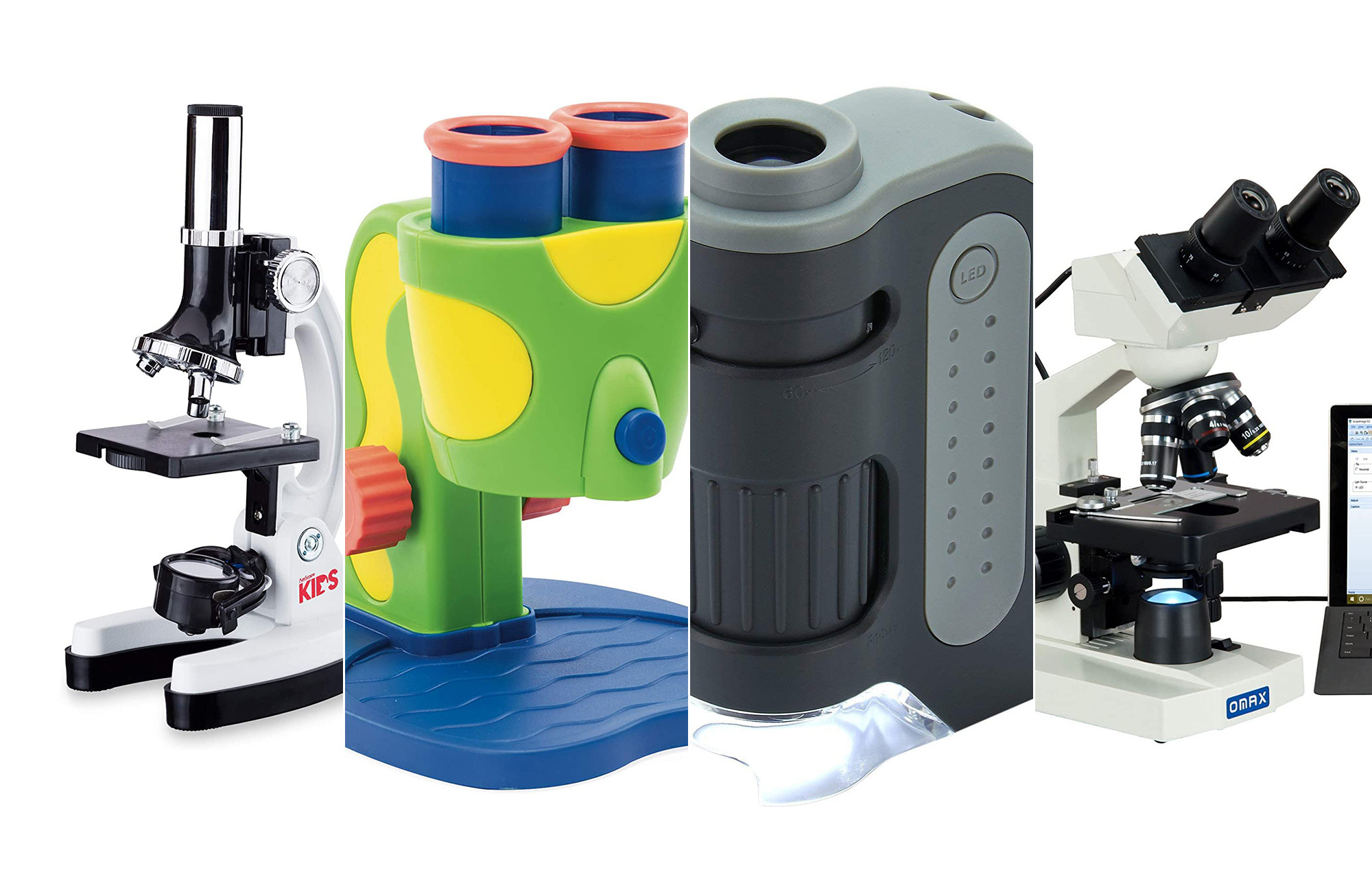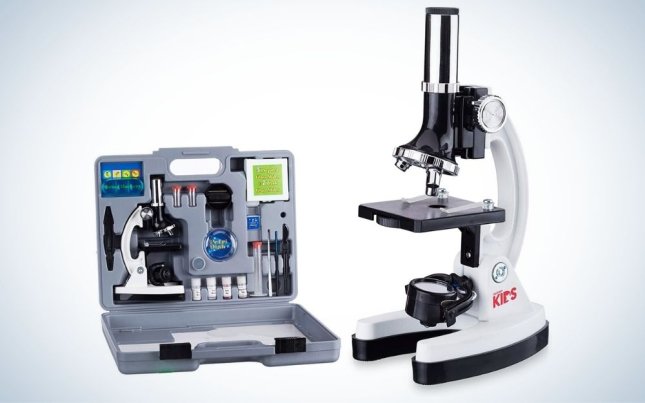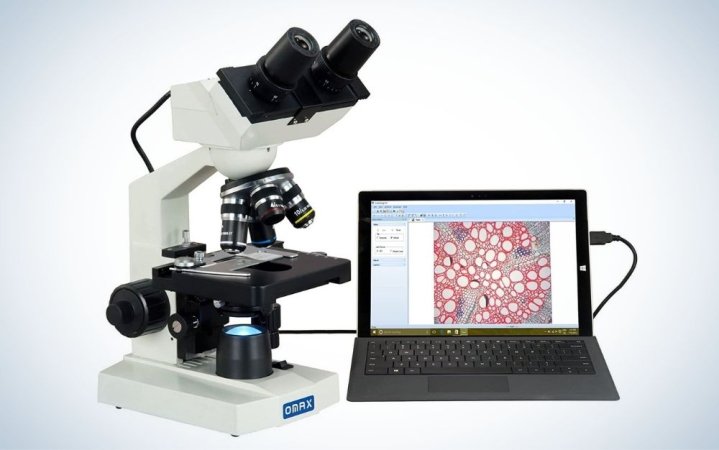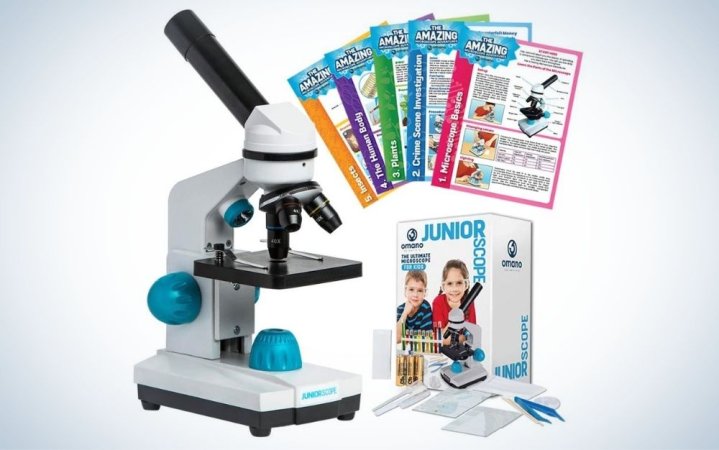We may earn revenue from the products available on this page and participate in affiliate programs. Learn more ›

When most people think of microscopes, they think of labs, schools, and serious research facilities—they don’t think about kids. But there are plenty of great options when it comes to fostering an interest in science at home. If you have a curious kid looking for a fun activity that revolves around exploration and learning, a microscope is a great option for an exciting gift. However, before you inspire your little scientist to get up close and personal, it’s important to understand which make and model will be right for their interests and maturity level. We’ll walk you through some of the features to look out for and recommend some of the best microscopes for kids on the market.
- Best overall: AmScope Beginner Microscope STEM Kit
- Best for older kids: OMAX-MD8 2ES10
- Best for young kids: Educational Insights GeoSafari Jr. Kids Microscope
- Best portable: Carson MicroBrite Plus Pocket Microscope
- Best kit: Omano JuniorScope Science Kit
- Best budget: National Geographic STEM Kit
How we chose the best microscopes for kids
We paid particular attention to each model’s durability and magnification power to select the best microscopes for kids of all ages. Children under seven won’t be able to use the features a more advanced microscope will offer, and older children might be disappointed by more rudimentary features made for younger kids, so we looked at light sources, stereo/compound power, and other technical specs to ensure a range of options to suit the spectrum of budding biologists. Finally, we searched for products with special features or science kits so your kids could start a scientific adventure the minute they open the box. We compiled our personal research and experience with online user impressions and critical consensus to select the best microscopes for kids.
The best microscopes for kids: Reviews & Recommendations
There are a lot of ’scopes to scope, so here are the ones whose profiles we choose to magnify.
Best overall: AmScope Beginner Microscope STEM Kit
Best overall
Why it made the cut: With a 52-piece set that kids can use right out of the box, this microscope is a great introduction to full-scale STEM research.
Specs
- Magnification: 120x-1200x
- Age Range: 8+
- Dimensions: 15.75 x 14.57 x 5.12 inches
- Light Source: LED
Pros
- Accessory kit
- Adjustable magnification
- Carrying case included
Cons
- Not suitable for younger kids
This beginner kit from AmScope includes a power monocular compound microscope with a color filter wheel, magnification ranging from 120x-1200x, LED light illumination, and a stain-resistant metal frame. Inside the ABS carrying case, you’ll also find a pair of tweezers, collecting vials, a Petri dish, prepared slides, Eosin dye, and more. You’ll even find a shrimp hatchery with Brine Shrimp eggs, so your kid can start their first science project immediately. If you’re looking for even more fun, grab AmScope’s World of the Microscope book, which includes additional projects and activities. This kit is recommended to be used under adult supervision and is unsuitable for preschool-aged kids.
Best for 10-year-olds: OMAX-MD82ES10
Best for 10-year-olds
Why it made the cut: A professional digital microscope that will give older kids the confidence and training to go further in their STEM journey.
Specs
- Magnification: 40x-2000x
- Age Range: 10+
- Dimensions: 9.06 x 7.09 x 12.99 inches
- Light Source: LED
Pros
- Professional quality
- Built-in 1.3MP Camera
- Swiveling binocular head
- Impressive Magnification
Cons
- Pricey
- Not suitable for younger kids
If you’re looking for one of the best digital microscopes for kids or the classroom, this option from OMAX is more advanced lab equipment than a lot of starter kits. It features eight levels of magnification: 40x, 80x, 100x, 200x, 400x, 800x, 1000x, and 2000x, making it the most powerful microscope on our list. It’s strong enough to show your budding biologist protozoa, cell walls, bacteria, and more. This digital compound microscope can connect via USB to Mac and Windows computers, and the built-in camera can take pictures and record videos of your findings so your kid can share their discoveries at the next family gathering.
If you’re not ready to spend that multifunctional model money but want a digital microscope, consider this wireless model from Skybasic with 50x-1000x magnification and WiFi connectivity.
Best for young kids: Educational Insights GeoSafari Jr. Kids Microscope
Best for young kids
Why it made the cut: The GeoSafari Jr. Kids Microscope is a great way to introduce science and discovery to young children; it’s constructed with small hands in mind, encouraging independent learning without sacrificing functionality.
Specs
- Magnification: 2.5x-8x
- Age Range: 3-6
- Dimensions: 1.12 x 8.1 x 10 inches
- Light Source: LED
Pros
- Inexpensive
- Binocular eyepieces suitable for kids
- Comes with 12 prepared slides
- Large viewing area
Cons
- Won’t be as fun for older siblings
This microscope from GeoSafari Jr. is an incredible way to introduce your kids to a wonderful new world full of zoomed-in discoveries. It’s designed explicitly with preschool-aged children in mind and features a large focus knob to help kids get used to magnification, starting with 2.5x and expanding to 8x. Two large eyepieces are comfortable and easy to use, eliminating the need to coordinate closing one eye. A push-button LED light and large viewing plate make this microscope easy to use; kids can independently place household objects and outdoor finds within view, plus, you can help them use the 12 included slide plates for a more advanced experience. One of the best for 5-year-olds, My First Microscope comes in two bright colorways, is made from lightweight yet durable plastic, and is battery operated so you can take it outdoors on a nice day.
Best portable: Carson MicroBrite Plus Pocket Microscope
Best portable
Why it made the cut: Weighing only 0.15 pounds, this pocket microscope is a great way for kids to get closer to nature during hikes, camping trips, and other outdoor adventures.
Specs
- Magnification: 60x-120x
- Age Range: 6+
- Dimensions: 3.5 x 0.79 x 1.97 inches
- Light Source: LED
Pros
- Affordable
- Lightweight
- Magnification power
Cons
- Works best on flat object
- Can be hard to use for little kids
This compact pocket microscope is an excellent way to explore the outdoors with your kids. While a little trickier to operate than some models made specifically for kids, it’s a great option for looking at leaves, insects, flowers, and more. An aspheric lens forces light rays to converge at a single focal point, allowing for more precise imaging aided by a bright LED light. With a magnification power range between 60x-120x, you’ll see some incredible detail, though it’s recommended that your kids start at the lowest magnification and work their way up. Using the MicroBrite to look at relatively flat objects resting on a flat surface is best, especially for kids still working on keeping a steady hand.
Best kit: Omano JuniorScope Science Kit
Best kits
Why it made the cut: A microscope is a great gift, but the JuniorScope Science Kit comes with five fun experiment cards that will keep your kids entertained after they inspect what they find around the house.
Specs
- Magnification: 40x-400x
- Age Range: 6+
- Dimensions: 9 x 6 x 14 inches
- Light Source: LED
Pros
- Comes with experiments
- Good value
- Suitable for a wide age range
Cons
- Larger objects can be challenging to view
This microscope kit from JuniorScope comes with three magnification levels, a glass lens, dimmable LED lighting, and a large EZ focus knob allows kids to operate the magnification levels independently. The full kit includes five fun experiment cards that will walk your kids through different ways to inspect various specimens, including insects, human bodies, plants, and crime scenes. Alongside the cards, this kit includes forceps, a Petri dish, dropper, test tube, blank slides, prepared slides, lens paper, and more. Look no further if you want a complete kit to guide a scientifically-minded kid.
Best budget: National Geographic STEM Kit
Best budget
Why it made the cut: A full microscope kit for under $40 that includes mineral chips, prepared plates, a lab guide, and more.
Specs
- Magnification: 40x-400x
- Age Range: 6+
- Dimensions: 12.05 x 11.05 x 6.81
- Light Source: LED
Pros
- Inexpensive
- Comes with tools and activities
- Soft eyepiece
Cons
- Build feels a little cheap
This kit from National Geographic is an affordable way to gift a microscope, equipment, and built-in experiments. The microscope itself features a soft eyepiece, large focus knob, and fixed lens, while the full kit comes with six plant slides, six blank slides, slide case, lab guide, pipette, tweezers, specimen dish, and more. It also comes with six mineral chips, including Pyrite, Amethyst, Rose Quartz, Blue Clacite, Geode, and Green Fluorite. We can confirm that adults and children alike will enjoy getting close to these sparkly rocks. The National Geographic STEM kit delivers a full gift set without breaking the bank.
What to consider when buying the best microscopes for kids
Just because kids can use these microscopes, that doesn’t mean their construction is completely different from lab-level models. They are still tools that come with technical specifications, and it’s important to understand how they work so you can confidently choose the right one for your young scientist.
Magnification and eyepiece
Microscopes are designed to zoom in on organisms and other matter, but the magnification power will differ across various models. Generally speaking, the younger the child, the lower the magnification power should be because powerful optics can be more difficult to operate. Microscopes with a 5X to 400X magnification power will be great for younger kids. Higher magnification, above 400x, should typically be reserved for kids over eight. These optics are also directly related to eyepiece type. A monocular eyepiece is used by one eye and can magnify up to 1000X. A binocular microscope supports more powerful magnification and uses both eyes, reducing eye strain.
Traditional or digital
You’ll likely see the words “traditional” and “digital” used to describe two different microscope types. A traditional model is probably best if you’re looking for an at-home microscope. A digital unit looks at the plate using a camera, projecting the image onto a screen—helpful for classroom settings or larger families with lots of young kids reluctant to take turns, but not the typical kitchen table use case.
Stereo or compound
Stereo and compound, also known as high or low power, describe the materials the microscope is designed to inspect. Stereo microscopes are considered low power and are great for exploring small surfaces in more three-dimensional detail: think coins, seashells, and rocks. Compound, high-power microscopes will give you a better look at living organisms, like plant matter, and rely on super small sections of the material to be put on a plate for closer inspection.
Longevity and durability
Traditionally, microscopes use small halogen or fluorescent bulbs to illuminate their subjects. If finding replacement bulbs fills you with dread, consider LED options, which are powerful, bright, and last for years.
Of course, the light source won’t matter if your microscope is made from fragile material and placed in the hands of a well-intentioned yet clumsy kid. Look for strong metals or thick, durable plastics. For kids under 5, grab a model with special safety features—like rubberized grips, padding around the eyepiece, rounded edges, and other features designed to be operated by small, inexperienced fingers. Of course, you can worry less about child-friendly design and more about magnification for older kids.
Accessories and kits
Ensure your microscope has all the tools necessary for full functionality; appropriate accessories might include plates, Petri dishes, pipettes, tweezers, etc. If you are gifting a microscope but are unsure how to use it in a fun, engaging way, go for a microscope kit with additional accessories. These kits typically include a variety of experiments or guides to get your scientific explorer started. As they grow, you can get them a telescope under $500 to look at the larger aspects of our universe.
FAQs
The best microscopes for kids range from $14-$300 based on their features, materials, and quality.
A child can start exploring microscopes as early as three years old. While you shouldn’t put a top-of-the-line research tool into the hands of a toddler, many early-childhood-aged children can interact well with a simple microscope designed for kids. As they get older, you can introduce more complex ideas and, therefore, more complex models to their play and learning. Kids as young as 9 or 10 can successfully operate more advanced binocular-style microscopes to great effect.
A 20x microscope will give you a closer look at the ridges and details on plant specimens, insects, shells, rocks, and other objects around the house. It’s a magnification level that will suit younger children well, though older children might be slightly disappointed. If they hope to zoom in on truly microscopic details, you’ll need a more powerful magnification; fine detail creeps in closer to 200x.
To see bacteria, you’ll generally need a compound microscope with at least 1000x magnification. A select few, like algae and yeast, can be seen between 200x-400x. You will likely need the right material to stain the bacteria first and experiment with the lens size. Too much magnification can lead to difficulty keeping samples in focus, and too little magnification will lead to blurry, unfocused viewing.
Final thoughts on the best microscopes for kids
- Best overall: AmScope Beginner Microscope STEM Kit
- Best for older kids: OMAX-MD8 2ES10
- Best for young kids: Educational Insights GeoSafari Jr. Kids Microscope
- Best portable: Carson MicroBrite Plus Pocket Microscope
- Best kit: Omano JuniorScope Science Kit
- Best budget: National Geographic STEM Kit
Shopping for the best microscope for kids shouldn’t be a process of trial and error, especially if you know what will suit the age of your little STEM explorer. As long as you don’t buy anything too advanced for smaller kids or too rudimentary for late-elementary to middle school students, you’re on track to deliver an amazing gift that will provide entertainment and learning. Consider the technical specs, pay particular attention to magnification, and think about any extra accessories that could go a long way. You’ll be conducting scientific research experiments with your future doctor/environmental scientist/zoologist/biologist/botanist in no time.








